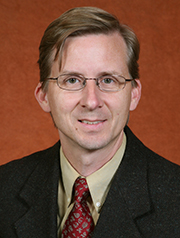CONTACT: Ron Hartung
(850) 645-9205
ronald.hartung@med.fsu.edu
By Ron Hartung
September 2009

Timothy Megraw, Ph.D.
TALLAHASSEE, Fla. -- If you don’t know how a human cell is supposed to work, it’s hard to offer a good explanation when the cell goes haywire -- as it does in cancer. That’s why a Florida State University College of Medicine researcher has been awarded a $1.2 million grant to explore the role of centrosomes and cilia in cell division and development and their connections to human disease.
Tim Megraw, a veteran researcher who joined the College of Medicine as an associate professor in August, received the four-year grant from the National Institutes of Health this month. The grant continues through August 2013.
The focus of Megraw’s work is cell division. Cancer occurs when renegade cells start dividing uncontrollably. Anti-cancer drugs such as Taxol, Megraw noted, target the microtubule, a key molecule that regulates cell division. Along with other areas of focus, he’s looking into microtubule regulation and its relationship to another component of the cell called the centrosome.
“We’re studying how microtubules are regulated in cells normally,” Megraw said, “and the key roles that the centrosomin family of proteins play in this process. Centrosomes are the main centers for organizing microtubules. So we’re interested in how centrosomes are assembled and regulated. Both of those goals are outlined in this new grant.”
Remarkably, centrosomins regulate not only centrosome assembly and their functions in cytoskeleton assembly, but also the replication of centrosomes in the cell cycle.
This is a continuation of work Megraw and his wife, Ling-Rong Kao, now an assistant in research at the medical school, began in 2003 at the University of Texas Southwestern Medical Center in Dallas. They have explored cells in the brain of the fruit fly and, more recently, the mouse.
Based on their work, researchers better understand the nature of centrosome-based diseases.
“Most of the diseases affect these little hair-like structures that stick out of our cells -- cilia,” said Megraw, noting that interest in cilia has experienced a renaissance in recent years. “It’s funny because, if you read a review article from 15 or 20 years ago, people wrote statements like ‘These appear to be useless vestiges.’ And now they appear to be key signaling centers. I have trouble keeping up with the list of diseases that are now associated with defective cilia.”
Among those diseases are polycystic kidney disease, as well as other syndromes that lead to deafness, visual degeneration, obesity and primary microcephaly, a condition in which brain development is impaired.

